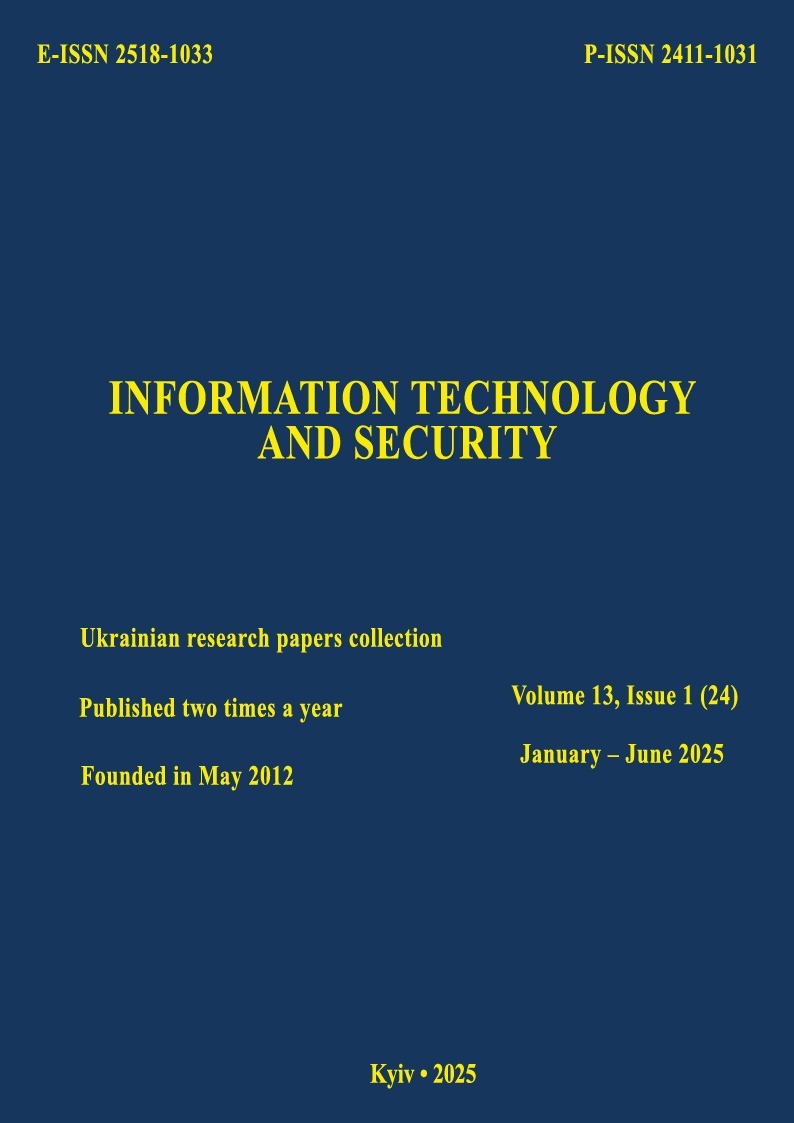Methodology for creating, clustering and visualizing correlation networks determined by the dynamics of thematic information flows
DOI:
https://doi.org/10.20535/2411-1031.2025.13.1.328753Keywords:
correlation networks, thematic information flows, clustering, visualization, dynamics vectors, content monitoring, cybersecurity, Gephi, Ph-Di diagram, semantic networksAbstract
Given the rapid growth of information circulating in social media and the Internet space, there is an urgent need for effective methods of analyzing and visualizing thematic information flows. Correlation networks are a powerful tool for formalizing such processes, as they allow identifying relationships between different objects, including by analyzing their dynamics. This is especially relevant for the cybersecurity sector, where prompt detection of trends and connections between events can be crucial. The article is devoted to the development of a methodology for creating, clustering and visualizing correlation networks determined by the dynamics of thematic information flows. The article proposes an approach based on the analysis of vectors of publication dynamics obtained through social media content monitoring systems. Correlation networks are formed based on relationships between vectors reflecting the distribution of documents by dates. To visualize and analyze the networks, tools such as Gephi are used, as well as the author's own Ph-Di diagram to display the dynamics of information flows. The methodology allows identifying groups of interconnected objects, which can be useful for analyzing thematic information flows, particular in the field of cybersecurity. The results of the study can serve as a basis for building probabilistic networks and further scenario analysis. The advantages of the proposed methodology are the low dimensionality of the vectors, which simplifies their processing and analysis, language independence, so that the methodology can be used to analyze information flows in different languages, and ease of implementation, which makes it accessible to a wide range of researchers and analysts in the field of cybersecurity.
References
D. Lande, L. Strashnoi, and I. Balagura, “Method for the formation and clustering of correlation networks of concepts”, Registration, Storage and Processing of Data, vol. 23, iss. 2, pp. 27-36, 2012, doi: https://doi.org/10.35681/15609189.2021.23.2.239209.
A. A. Snarskii, D. V. Lande, D. I. Zorinets, and A. V. Levchenko, “Reciprocally time correlating objects ranking”, in Proc. XVII Inter. Scien. Conf. Named After T.A. Taran “Intell. An. of Inform. (IAI 2017)”, Kyiv, 2017, pp. 216-221.
D. Lande, “Formation of a semantic map of concepts in the field of parliamentary control”, Information and Law, iss. 4 (47), pp. 116-123, 2023, doi: https://doi.org/10.37750/26166798.2023.4(47).291611.
D. Lande, O. Puchkov, and I. Subach, “A system for analyzing large amounts of data on cybersecurity from social media”, Information Technologies and Security, vol. 8, iss. 1, pp. 418, 2020, https://doi.org/10.20535/2411-1031.2020.8.1.217993.
D. Lande, O. Puchkov, and I. Subach, “Aggregation of information from diverse networks as the basis for training cyber security specialists on processing ultra-large data sets”, Information Technologies and Security, vol. 9, iss. 1, pp. 4-16, 2021, doi: https://doi.org/10.20535/24111031.2021.9.1.247256.
D. Lande, OSINT in cybersecurity: A textbook. Kyiv, Ukraine: “Engineering LTD”, 2024.
K. Cherven, Mastering Gephi Network Visualization. Birmingham, UK: Packt Publishing, 2015.
G. Adomavicius, and J. Zhang, “Classification, ranking, and top-K stability of recommendation algorithms”, INFORMS Journal on Computing, iss. 28 (1), pp. 129-147, 2016, doi: https://doi.org/10.1287/ijoc.2015.0662.
A. Saxena, M. Prasad, A. Gupta, N. Bharill, O.P. Patel, A. Tiwari, and C.-T. Lin, “A review of clustering techniques and developments”, Neurocomputing, iss. 267, pp. 664-681, 2017, doi: https://doi.org/10.1016/j.neucom.2017.06.053.
A.K. Jain, “Data clustering: 50 years beyond K-means”, Pattern Recognition Letters, vol. 31, iss. 8, pp.651-666, 2010, doi: https://doi.org/10.1016/j.patrec.2009.09.011.
P. Luo, K. Shu, J. Wu, L. Wan, and Y. Tan, “Exploring correlation network for cheating detection”, ACM Transactions on Intelligent Systems and Technology, vol. 11, iss. 1, pp. 1-23, 2020, doi: https://doi.org/10.1145/3364221.
A. Kassambara, Network Analysis and Manipulation Using R: Quick Start Guide. STHDA, 2017.
N. Masuda, Z.M. Boyd, D. Garlaschelli, and P.J. Mucha, “Correlation networks: Interdisciplinary approaches beyond thresholding”, arXiv preprint arXiv: 2311.09536, 2023.
T. Triantoro, “Graph Viz: Exploring, analyzing, and visualizing graphs and networks with Gephi and ChatGPT”, in ODSC Community, March 30, 2023. [Online]. Available:https://opendatascience.com/graph-viz-exploring-analyzing-and-visualizing-graphsand-networks-with-gephi-and-chatgpt. Accessed on: Feb. 19, 2025.
Y. Liu et al., “Revisiting modularity maximization for graph clustering: A contrastive learning perspective”, in Proc. 30th ACM SIGKDD Conf. on Know. Disc. and DM, Barcelona, 2024, pp. 1968-1979, doi: https://doi.org/10.1145/3637528.3671967.
M. Zgurovsky, D. Lande, K. Yefremov, O. Dmytrenko, A. Boldak, and A. Soboliev, “Extracting and identifying relationships of key phrases in information flows”, in Proc. 2022 IEEE 3rd Intern. Conf. on Sys. An. & Intell. Com. (SAIC), Kyiv, 2022, pp. 4-7, doi: https://doi.org/10.1109/SAIC57818.2022.9923019.
Downloads
Published
How to Cite
Issue
Section
License
Copyright (c) 2025 Collection "Information Technology and Security"

This work is licensed under a Creative Commons Attribution 4.0 International License.
The authors that are published in this collection, agree to the following terms:
- The authors reserve the right to authorship of their work and pass the collection right of first publication this work is licensed under the Creative Commons Attribution License, which allows others to freely distribute the published work with the obligatory reference to the authors of the original work and the first publication of the work in this collection.
- The authors have the right to conclude an agreement on exclusive distribution of the work in the form in which it was published this anthology (for example, to place the work in a digital repository institution or to publish in the structure of the monograph), provided that references to the first publication of the work in this collection.
- Policy of the journal allows and encourages the placement of authors on the Internet (for example, in storage facilities or on personal web sites) the manuscript of the work, prior to the submission of the manuscript to the editor, and during its editorial processing, as it contributes to productive scientific discussion and positive effect on the efficiency and dynamics of citations of published work (see The Effect of Open Access).

